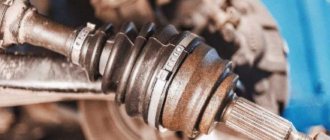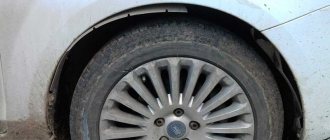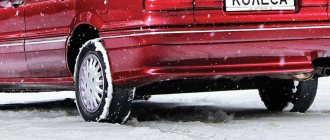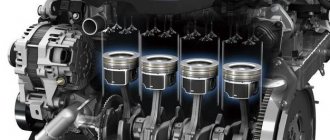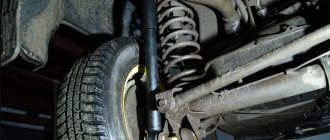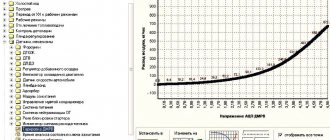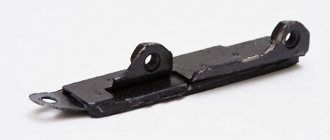- home
- Engine
- …
This article will be of interest to many car owners who have a timing chain drive. The bottom line is that sooner or later, under the head cover, a “knock”, “clanging”, in general, something rattles there. This is really stressful! After all, there is definitely a problem with the chain or its tensioner; if you mess it up, you can end up with a very major repair. On the other hand, owners for whom nothing has happened yet, the engine is working properly, want to know what kind of noise it is? It is DESIRABLE to hear it, both for yourself and on video. That's all about today's article...
I have already written and said many times - that if the connecting mechanism breaks, usually a chain or belt , then you can end up with a very large repair. In special cases, it is easier to buy a contract engine than to repair this one! If you don't believe me, let's touch on this topic a little.
Why does the timing chain rattle?
Any knocking or noise in the engine is a sign of a malfunction; operating a car with such a defect is unacceptable. You should also not drive a car with a noisy timing chain - the consequences can be unpredictable, and in the worst case, you may have to completely change the power unit.
Any chain drive of a modern car has a certain resource; on average, tensioners, chains, dampers, sprockets should be replaced after 150-250 thousand kilometers; the service life of parts depends on the specific model of the internal combustion engine. But the timing components of a gasoline engine may fail ahead of schedule, and here are the main reasons:
- failure to promptly change engine oil or use the wrong brand;
- low quality of spare parts; non-original spare parts usually do not last long;
- insufficient amount of lubrication, low pressure;
- design features of a specific power unit model;
- incorrectly selected operating mode;
- poor quality maintenance and repairs.
One of the most common malfunctions is a jamming of the tensioner plunger or failure of the check ball valve; often the breakdown occurs due to coking and the formation of oil deposits. As a result of weak chain tension, a uniform engine noise appears, similar to the operation of a diesel engine; as a rule, it is clearly audible at idle speed, on a cold internal combustion engine. Due to weak tension, the timing chain begins to stretch intensively and can jump on the teeth.
Is it possible to drive?
In short - NO NO! We immediately go to the service station and look for the causes of this malfunction. Of course, if the chain rattles for a short period of time, you have a few days, maybe even weeks. But again, I wouldn't wait. All this can end very badly!
When replacing, I also do not advise you to save money - we change the tensioners, the chain, you should not change everything separately. As a rule, the complete set is changed, especially if your mileage is really high.
Now let's watch the video version
I’ll end here, I think my article and video were useful to you. Sincerely yours, AUTOBLOGGER
Similar news
- After how many engine hours should you change the engine oil? Must know...
- Adsorber. What is it in a car, what is it for, what does it affect...
- How to unscrew the oil filter (without using a wrench). What to do if...
Add a comment Cancel reply
What happens when the timing chain breaks and is pulled out?
When the timing chain is stretched, it eventually begins to make noise not only at idle, but also at higher speeds, as a result of prolonged operation with chain noise:
- the chain jumps, which causes the marks and valve timing to go astray;
- the gas distribution mechanism drive breaks with all the ensuing consequences.
When the chain drive links jump, the engine begins to work intermittently, power is lost, and in some cases the engine may not start at all. If a break occurs, at least it bends the valves on 16-valve internal combustion engines, in the worst case, in addition to this:
- piston heads are damaged;
- the front engine cover breaks (a hole may form);
- the cylinder head seats crumble;
- scoring occurs on the surface of the cylinders.
Basically, a break in the timing chain threatens the overhaul of the power unit, often due to the high cost of parts and the work itself, it is more profitable to buy a contract engine than to repair the engine.
How to understand: the problem is in the hydraulic tensioner or the hydraulic compensators are faulty?
Before diving deeper into the nature of the problem, you need to figure it out and be sure that the problem is with the hydraulic tensioner and not with the hydraulic compensators. How to understand what exactly went wrong? You can determine it yourself without a car mechanic in this way: if the hydraulic tensioner has failed, it stops rattling when the speed rises at startup. And if there is a problem with the hydraulic compensators, then even when the speed rises at startup, the rattling sound will still remain.
Replacing the timing chain
The material of the chains of modern engines no longer has the strength that was characteristic of the gas distribution mechanism drive parts of cars of the late 19th and very early 20th centuries, and due to the heavy load on turbocharged engines, the service life of spare parts in other cases does not exceed 100 thousand. km. If extraneous noise appears under the hood, it is necessary to immediately find out the cause of the defect; the car owner always has two options:
- figure out the problem yourself;
- contact a service station.
When diagnosing yourself, first of all you need to troubleshoot the tensioner, remove it and do an external inspection. Replacing a timing chain with your own hands is a rather difficult and time-consuming operation, and if the car has an internal combustion engine of a complex design, it is better to entrust the repair to professional craftsmen.
Good afternoon, dear visitors of this wonderful forum. I've been reading it for a long time, and with its help quite a lot has been changed. I placed the topic for beginners, because... it's not new. But please don’t swear - I’ve already read everything that concerns her on this forum. My situation, I think, is a little different. And everyone’s situations are different, and so are the ways to solve the problem. I hope for your understanding and help.
I’ll try not to spill too much water, but describe the breakdown in as much detail as possible: I’ve had the car for a year now, Liberty QR20de RM12 2001, mileage on the display is 127 thousand.
After half a year of operation, a soft clanging sound appeared from the timing mechanism, about which so much has already been written here. It appeared when climbing a hill, when accelerating from a standstill at 1600-2000 rpm, I also tried to simulate the load - I put the handbrake on, held down the brake, in D. I picked up 1700 rpm - it crackled and squelched.. We took off the belt, checked, the sounds did not disappear, overtaking the clutch was excluded, and it, in principle, is still new (it was changed due to symptoms - upon startup, an increasing crackling sound, the light blinks, the voltage in the on-board network is 10.8 V. The crackling stopped and everything returned to normal - this is understandable, The generator rotor didn’t engage, but that’s not the point—it just might help someone).
I started thinking about the chain. I read smart articles and decided to remove the cover on the left to look at the output of the chain tensioner. But apparently I didn’t read the clever articles to the end, I didn’t fix the tensioner piston, and voila - one movement, and it and the spring together flew to freedom into the bowels of the engine. Live and learn..
I think that if I had a garage, I would decide to open it myself. But since my car spends the night on the street, time is rushing, the weather is not good, and the time that remains after work for repairs is a couple of hours before dark, I had to go to a service center. I bought the repair kit myself, not the original. At the service center, after replacing, I asked to tighten the old filter and fill in the old oil, because... In this regard, I don’t trust the services, they dilute the oil. I picked it up after repairs and drove a kilometer to the house. While driving, it rattled like a tractor. I washed it, changed the oil right away, filled it with Eneos 10w-40 semi-synthetic, and drove it fine last summer. In winter I poured 5w-30 of his own. Our temperatures in winter are -35 plus the same in summer. Filter tightened by MASUMA, 200 rub. I filled the filter with oil before tightening it. After changing the oil, the engine began to run quietly. Only for some reason it began to start with a roar, 1-2-3 seconds. If you turn it off and start it again right away, it will start quietly, if you wait 20 seconds, it will start with a roar. I read that it’s normal that the pressure drops in the hydraulic tensioner, but I don’t understand why it happens so quickly? I read it and added oil to the top mark. Now, in order to start it again without rattling, you can wait 40 seconds. If it’s longer, it rattles. Moreover, it doesn’t matter whether the engine is warmed up or not. In principle, I was ready to put up with the roar at every start-up, but the next day everything returned to where it all began. It rumbles during acceleration, at 1700 rpm, if you simulate the load by holding the brake and applying the gas, when going up a hill.. If, by the way, you try to drive up a hill backwards, it starts to rumble already at 1300 rpm. Moreover, the sound became louder after the replacement. There is no sound in “P” mode or in neutral. Coasting is also quiet.
And one more important nuance - in the morning, when it’s cold, after the already familiar rumble at startup, there are no extraneous noises at all. No matter how much gas you get, uphill or downhill, it’s an absolutely serviceable car. After about 20 minutes, as it warms up, unpleasant symptoms begin to appear. BUT, if you accelerate very, very, very, very smoothly, there will be no clanging or rumble.
In total we have:
Before replacement: 1. A rustling clanging sound when accelerating, at 1700 rpm, or when going up a hill. 2. There is NO roar at start-up. 3. The old chain turned out to be 3 mm longer than the new one. 4. The tensioner rod, when I removed the cover, was extended as in the photo below, it was exactly 10 mm.
After replacement: 1. The clanging sound is much louder, at the same speed, or when going uphill. 2. There is a rumble at start-up. There is no roar if you start it IMMEDIATELY after you turn it off, if you wait 30-40 seconds, we hear a roar for about 3 seconds. 3. The new chain is 3 mm shorter than the old one. 4. I haven’t had time to measure the tensioner rod yet.
The service center said change the oil to the original 0w20, the filter to the original one, if that doesn’t help, look at the VVTi clutch. But I would like to listen to the opinions of people who are more knowledgeable about the problems of this engine. I don’t have much money to invest anymore, I don’t want to change everything in a row.
In this regard, everyone has a lot of questions...
1. Why did the thunder become louder? 2. Why was there no rattling noise at startup before the replacement, although the chain was stretched? 3. Why does it rattle again when restarted? Does the oil disappear that quickly? 4. The most interesting thing is why everything is fine when it’s cold and loud when starting up? 5. Why is everything quiet if you accelerate super slowly?
What to blame and where to start - original filter, oil pump, removing the cap and visual inspection? Maybe try installing the old tensioner, maybe the new one is of poor quality?.. I'm at a loss. I hope for adequate criticism and your advice.
I am attaching photos and videos for the first time, I hope it worked. In the photo: Tensioner rod output: or Gear wear: or Video of the chain condition before replacement:
Rumble on startup. In motion, with the symptoms I described, the sound is similar, only longer:
Why is the engine knocking?
There can be many possible reasons for engine knocking. In the list of the main ones, experts note wear of parts inside the internal combustion engine, as well as detonation knocks. The degree of wear and a number of other factors will determine the nature of the knock, which can be from quiet and muffled to distinct metallic knocks inside the engine. After the engine starts when cold, a knocking noise in the engine becomes audible, which, when warmed up, can:
- disappear completely;
- become less noticeable;
- stay at the same level;
- increase with increasing temperature and load;
Motor wear
A cold engine that shows no other signs of trouble can often start knocking if the thermal clearances are not correct. In other words, engine knocking may indicate the need for valve adjustment.
The reason for knocking when cold can also be hydraulic compensators that have lost their functionality as a result of wear, the use of the wrong type of engine oil, or untimely replacement of it during the operation of the car. To eliminate the knocking of hydraulic compensators when cold, a routine engine flush can often be sufficient, followed by changing the oil and oil filter.
Separately, it is worth highlighting the knocking of the connecting rods. The appearance of such a knock is accompanied by dull impacts of metal on metal, a worn connecting rod hits the crankshaft journal. Connecting rod and piston knock on a diesel engine can be more distinct and loud, since the pistons in a diesel engine are structurally very close to the cylinder head. Operating an engine, regardless of its type, with such a knock is strictly prohibited, as the engine may unexpectedly jam.
The timing belt itself can knock when cold. The reason is again increased clearances in the camshaft bed. As it warms up, the knocking becomes less intense or goes away completely. One of the no less serious breakdowns is piston knock. The piston may knock as a result of destruction or critical wear. Worn pistons “walk” in the cylinder, creating metallic impacts on the piston skirt. Also, in some cases, such a knock can be caused by broken piston rings.
Detonation knocks
Detonation is possible both on a cold engine and on a warm power plant. Detonation knocks after starting the engine or while driving are characterized by a fairly loud knock, the frequency of which increases with increasing speed. The reason is unevenness and untimely ignition of the fuel-air mixture, which leads to explosions inside the cylinders. The load on the CPG and the crankshaft drive greatly increases, acquiring an impact destructive character.
How to determine that the chain drive is knocking?
Actually, this sound is quite strong, metallic and clinking. Many call this sound similar to the operation of a diesel engine, that is, there will be a kind of “dieseling” present. Of course, I will have everything in the video version below
As I already wrote above, it can manifest itself in three stages:
- Rattles when “cold”
- Knocks on "hot"
- Sound when under load. For example, if you accelerate, no, but when you let off the gas, there is
- Constant metallic noise
Of course, it’s difficult to understand in words, so I advise you to watch the video version below
When is stretching necessary?
The gas distribution mechanism on the VAZ 2107 injector consists of the following elements:
- intermediate and crankshaft gears;
- camshaft and intermediate shaft;
- rocker;
- sedative;
- intake and exhaust valve;
- tensioner;
- shoe;
- timing chain drive.
The photo shows timing parts.
Components of the gas distribution mechanism
Thanks to the timing belt, the air-fuel mixture is supplied and exhaust gases are removed. Its operation is carried out using a chain drive or belt. They transmit torque from the crankshaft to the camshaft.
The shafts must be in a certain position. To do this, special marks are placed on the crankshaft pulley and the camshaft sprocket, which must be set correctly. If the marks do not match, serious problems with the engine may occur, including major engine repairs.
During operation, the chain drive and belt are under constant tension, so after a while the chain gradually stretches out - its pitch increases. In this case, the engine begins to idle unstably, the speed begins to fluctuate, and the engine may stall.
If metallic sounds appear when increasing or decreasing speed, this is a sure sign of stretching of the chain drive or wear of the damper. To eliminate these sounds, you need to tighten the chain or replace the damper. Chain drive tensioning should also be done after replacing any timing parts, including the guide rail and shoe.
The chain drive on the VAZ 2107 injector is adjusted using a tensioner, which can be a mechanical, automatic or hydraulic tensioner. To install a hydraulic tensioner on a VAZ 2107, you need to redo the timing belt. Instead of the standard one, an automatic tensioner is often installed; it is more reliable.
Diagram of the gas distribution mechanism
Which hydraulic tensioner should I choose and where to buy it?
If, after the simple analysis described above, it became clear to the car owner that the problem is with the hydraulic tensioner, then he will then need to carry out a series of actions. The first thing you need to pay attention to is the engine. The first thing you need to do is check its oil level. It is also a good idea to check the serviceability of the tensioner and damper shoes. If they are normal, auto mechanics advise replacing the defective part with an automatic chain tensioner.
You can put either , or Isai . Some car experts recommend an alternative option - ESPRA. Hydraulic tensioners from the above companies for the Chevrolet Niva are not difficult to find today. They are available in almost all auto stores. But they can also be purchased online.
Consequences of a loose chain on a VAZ 2107
This applies to 2106 and all classics in general. First of all, the chain is manufactured with high precision and durability. This means that at the slightest jump of teeth, the engine will work at random. This is especially true for injection engines, since the crankshaft position sensor will give one reading, but in fact, the shaft will be in a completely different position. Moreover, jumping two or more teeth is fraught with the risk that the valve will punch a hole in the piston, and such a disaster will occur in all cylinders, and if, when the belt breaks, for example, the timing parts move simply by inertia, then in this situation they are still driven into movement from the crankshaft.
The next problem is wear of the head housing. It has a special part near the camshaft gear. So, aluminum wears off very easily at high speeds, and then restoring the head can be very problematic. The same goes for the tin valve covers. In general, timely tensioning of the chain on a VAZ 2107 is a mandatory procedure.
One of the most critical components in any car is the gas distribution system. The operation of the entire engine depends on its serviceability. If the phases are shifted by even one tooth, dips will begin and the speed will destabilize. The motor will run unsteadily. But how to maintain this unit in good condition? Let's look at how to properly tension a chain on a VAZ-2107 and how to identify the symptoms of a malfunction.
Tightening the chain while removing the valve covers
If the chain is still noisy, perform the following operation. Using keys, we remove not only the drive, but also the valve cover from the cylinder head side. In this case, the chain tension can be checked manually as the camshaft sprocket is released.
So, loosen the tensioner a little and turn the crankshaft two turns. After this, fully tighten the timing chain tensioner. Next, we check the element manually. There should be no sagging. The chain must be elastic. If so, replace the valve cover and drive cover.
Cracking on a cold engine: twin-shaft timing and variable valve timing system
Let's start with the fact that many modern engines have quite a lot of power with a relatively modest displacement.
This became possible not only due to the installation of turbocharging and other similar solutions for boosting the internal combustion engine, but also due to the integration of two camshafts into the timing belt, an increase in the number of valves per cylinder, and the active use of variable valve timing systems.
As a result, even a naturally aspirated engine with similar solutions has become much more powerful, more flexible and more responsive in an extended speed range. However, owners of such engines often note at 70-120 thousand km that when starting the engine when cold, a cracking sound is heard, which disappears after 5-10 seconds. If the engine warms up even slightly, in this case no suspicious noises appear until the next cold start.
So, the culprit of the problem may well be the variable valve timing system, which various manufacturers call VVT-I Toyota, i-VTEC Honda, MIVEC Mitsubishi, VANOS BMW, etc. Let us immediately note that solutions from different manufacturers differ in design. Moreover, the presence of this system does not mean that it is it that is causing the problems, but there have been cases where the problem lies precisely in it.
For example, owners of a Honda Accord with a K24 twin-shaft engine are faced with the problem of crackling noise when cold precisely because of problems with the i-VTEC system. Let's look at this in more detail, since similar problems often occur with other automakers.
In a nutshell, i-VTEC was a continuation of the well-known VTEC system, and the prefix “i” began to indicate that Honda has made the valve timing control system more “smart.” If the simple early VTEC worked only from special cams on the camshaft, and the valve lift was controlled without the use of any other devices, then in the case of the i-VTEC system it became possible to change the phases in all modes of operation of the internal combustion engine.
As a result, fuel consumption decreased at low speeds, while at high speeds a recognizable increase in power and pickup remained. Also, the valve timing began to change smoothly and imperceptibly for the driver. The only negative is that the system itself has become more complex.
We also recommend reading the article on how to determine what is knocking in the engine. From this article you will learn about the causes of knocking, as well as ways to determine a particular problem.
Let's move on. The ability to flexibly change phases was made possible by installing a special device on the intake camshaft, which is known as a VTC phase regulator. In fact, the solution is a type of split gear that is capable of setting the phase shift not constantly, but dynamically, in real time. This is made possible by the fact that VTC operates based on engine oil pressure.
It turns out that the lower the pressure in the oil system and the lower the engine speed, the more the phases shift taking into account the lean mixture. However, as soon as the driver presses the gas pedal, the gear moves relative to the shaft in the direction of greater fuel supply. The result is better cylinder filling and a noticeable increase in power.
Note that it is the VTC that eventually begins to make a cracking sound when starting from a cold state. The problem lies in the design of this, so to speak, gear. The solution is hollow inside; engine oil moves in this cavity. There is also a mechanical lock of the gear to the shaft.
This clamp allows you to attach the gear to the shaft if there is no oil pressure. In other words, if there is pressure, it presses the gear; if there is none, the fastening is carried out by a clamp. Moreover, during operation, this retainer becomes clogged with various contaminants that are present in the engine oil, that is, the retainer becomes coked.
In this case, the latch is not able to work normally, and the crackling noise itself, which is heard after starting, is the attempt of the coked latch to return to its place. The specified crackling noise is heard in the engine until the gear is adjusted due to oil pressure. In practice, you can try to clean the gear from contaminants, but often the cracking will appear again after some time. The fact is that the retainer usually turns out to be already worn out, so it is optimal to immediately replace the entire part.
How to check chain tension
The VAZ 2107 timing chain is located in the front part of the engine. It is closed on top by the cylinder head cover, on the bottom by the engine sump, the middle part runs inside the block and can only be reached by removing the chain.
To check the chain tension, simply remove the cylinder head cover. To do this, you need to unscrew the 8 fastening nuts. After removing the cover, the gasket must be replaced. It is inexpensive, but if this is not done, after installing the cover with the old gasket, it is almost guaranteed that oil will begin to ooze from under it.
When the "valve cover" is removed, the top of the chain is exposed. You can check the tension with your hands, but it is better to use a large screwdriver. It must be inserted between the chain and the cylinder block body and, using it as a lever, try to bend the chain. In this case, the chain should not bend. The tension must be checked on both sides - on the left and right sides of the engine. A chain that is taut like a string and does not bend when pressed with a screwdriver or fingers is a sign of its correct tension. Otherwise, it must be tightened or replaced.
Important: Do not apply too much force by pressing the chain as hard as you can. This can lead to deformation of the chain links. Therefore, it is necessary to press “half-heartedly.”
Automatic tensioner system
Automatic tensioner
Some car owners of classic VAZs replace the standard chain tensioner with an automatic one of the “Pilot” type. The automatic tensioner does not require maintenance after installation and, without the intervention of a technician, ensures that the chain is tightened as it stretches. The advantages of the Pilot device include:
- no need to supply an oil line, which eliminates chafing of the VAZ 2107 injector timing chain and loss of oil pressure;
- the absence of plunger elements, which is why the automatic chain tensioner “Pilot” does not jam;
- the movement step is 1 mm, which allows you to regularly monitor the degree of tension;
- no shoe wear;
- reduction of motor noise;
- increasing the service life of all timing components;
- long service life - about 25 years.
The “Pilot” chain tensioner improves the performance of the VAZ 2107 injector engine due to the precise execution of valve timing. The process associated with how to tension the chain is carried out regardless of the operation of the car engine.
The timing chain and belt are important parts of the gas distribution mechanism. Over time, the chain stretches and requires adjustment. The article talks about when tensioning is necessary, and also gives step-by-step instructions on how to tension the chain on a VAZ 2107 with your own hands.
[Hide]
Main Causes of Circuit Failure
As the engine speeds up, the chain begins to rattle. In this case, the metallic ringing goes away as the speed decreases. A stretched timing chain contributes to a gradual shift in the valve timing, which leads to engine malfunctions.
All owners of cars of this brand should know how to tighten a chain on a VAZ 2107. This work is performed using a “13” wrench and a hammer. The chain is adjusted as follows.
- The tensioner is discharged. When performing this procedure, the shoe should snap off. If this does not happen, it means that the timing chain tensioner plunger is stuck. The problem is eliminated by tapping the unit body with a hammer.
- Using a key set to “13”, the cap nut is unscrewed.
- Using a special crankshaft wrench, the pulley is turned a couple of turns.
- The crankshaft stops at the moment of maximum rotational resistance. In this position, tension is applied.
- While holding the crankshaft from turning in the opposite direction, tighten the cap nut.
- The cylinder head cover is being installed.
In some cases, such tension is ineffective. Experienced auto mechanics know how to tighten the VAZ 2107 injector chain. To do this, you will need the following tools: 8 and 10 sockets, pliers and a ratchet with a handle. The valve cover is unscrewed and dismantled, thus providing access to the camshaft sprocket. The chain tension is checked manually.
The next step is to turn the crankshaft of the VAZ 2107 injector several turns. This work is carried out by turning on the starter for a few seconds or using a wrench that is placed on the ratchet.
The next step in solving the problem of how to tension a chain is to check the tension. To do this, it is recommended to click on the side branch of the mechanism in question. This procedure is carried out until the desired result is achieved. After this, the tensioner bolt is screwed in until it stops. To ensure that the work is completed correctly, a special scheme is used.
How to tension a chain on a VAZ-2107 without removing the valve covers?
First we need to place the car on a flat surface and secure it with anti-roll bars. Next, fix the gearshift lever in the neutral position. Then remove the drive cover. Once access to the chain is free, the tensioner should be slightly loosened. It is located next to the water pump. Next, using a 36-degree socket, rotate the crankshaft 360 degrees. After this, tighten the tensioner to the maximum. We start the engine and check the tension level. The clatter must disappear.
Step-by-step instruction
Before starting work on tensioning the chain, the car must be placed in a comfortable position. Place the gearshift knob in the neutral position and secure the wheels so that the car does not roll during the procedure.
Tools
To carry out the work, the following tools are required:
- set of socket wrenches;
- set of heads;
- pliers;
- screwdriver;
- hammer.
Before starting work, you should make a visual inspection of the chain drive. If mechanical damage is found to the tension roller, shoe, guide, sprockets or chain, the defective parts must be replaced.
Stages
The sequence of work when tensioning the chain both in an engine with an injector and with a carburetor consists of the following steps:
Sometimes tensioning is impossible because the chain stretches over time and the plunger is no longer long enough to make the adjustment. If you do not plan to change the product, then for temporary driving you can increase the tensioner rod, for example, by attaching a bushing to the end of the rod, with which the air filter is attached. But still, a worn-out product must be replaced in the near future.
